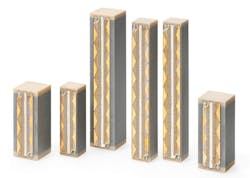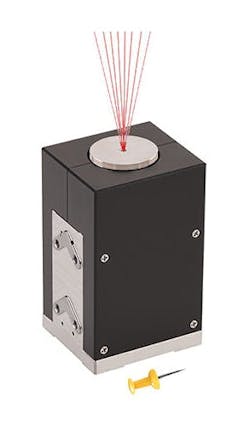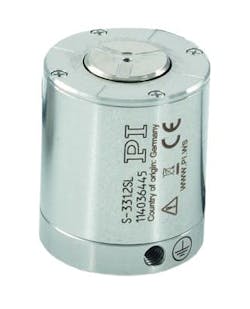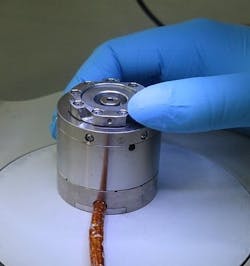Laser Beam Control with Fast Steering Mirrors and PICMA Piezo Actuators
Actuation technologies for various applications—ranging from processing and stabilization to optical trapping and laser scanning—continue to advance for a range of industries and applications, including aerospace, optics and photonics, lasers, ophthalmology and optical scanning.
The combination of the PICMA piezo actuators and the S-335 fast steering mirror (FSM) from Physik Instrumente is designed to provide millisecond response and settling times as well as dynamic linearity. The FSM is made for fast and high-resolution motion in two degrees of freedom. Based on solid-state piezo drives, it is suitable for precise, high-speed laser beam control and high-resolution imaging applications. Its long angular travel range is made possible using motion-amplified piezo actuators, operated in a differential push-pull mode for each axis. Closed-loop control with feedback sensors provides repeatability and accuracy.
The S-335 two-axis tip-tilt mirror offers 35mrad of mechanical angular deflection in two axes and 70mrad optical deflection. For ultra-long lifetime, all PI piezo mirror mounts are equipped with PICMA multilayer piezo stacks that are ceramic-encapsulated and have excelled in 100 billion cycles of life testing for the Mars Rover Space mission.
PI also provides voice-coil driven steering mirrors with larger travel ranges as well as space-qualified fast steering mirrors for LEO satellites.
FSMs are used to direct laser light or improve image resolution by correcting errors in a wavefront before it reaches an imaging sensor. Image resolution can also be improved when operated in pixel shift mode, where sub-pixel resolution can be achieved by actively moving the sensor or the light reaching the sensor by fractions of a pixel.
A standout attribute of the system is its parallel-kinematics design, which uses coplanar rotational axes and a singular moving platform driven by differential actuators. This is designed to offer jitter-free, multi-axis motion with temperature stability.
Because of the interplay between the technologies, Machine Design reached out to Physik Instrumente to learn more about the actuators to understand their durability, which directly affects the long-term reliability of these FSMs. Stefan Vorndran, vice president of marketing, provided answers.
Editor’s note: Questions and answers have been edited for clarity, space and style.
Machine Design: What specific design features of the piezo actuators contribute to their resistance to environmental factors such as humidity and temperature fluctuations? How do these features compare with traditional actuators?
Stefan Vordran: The function of piezo actuators is based on solid-state effects that occur inside the crystalline structure of the piezo cells. Most piezo actuators have a wide operating temperature range, typically up to 150°C and 200°C, and −40°C. Some, [such] as the ceramic insulated PICMA actuators, can operate down to cryogenic temperature ranges. Modern piezo actuators are mostly based on a multilayer ceramics—similar to multilayer ceramic capacitors, where all layers and electrodes are produced in an automated process. Traditional discrete piezo actuators are made of individual ceramic wafers, stacked with bonded electrodes in between.
Since they are based on ceramics, temperature fluctuations do not affect piezo actuators as much as traditional actuators based on combinations of aluminum and steel. Piezo actuators don’t require lubricants such as most traditional actuators, which is another advantage.
READ MORE: The Vision of Sustainable Agriculture: Laser-Focused on a Weed-Free Farm
High humidity can be an issue with traditional piezo actuators that rely on a conformal coating to protect its electrodes. These coatings will eventually be permeated by moisture. PI’s patented PICMA multilayer piezo actuator technology uses a ceramic coating that significantly better protects the actuator and provides a much longer lifetime.
For applications that require immersion in liquids, piezo actuators can be hermetically sealed.
MD: Can you elaborate on the manufacturing process for the piezo actuators? What quality control measures are in place to ensure their reliability over such extensive operational lifetimes?
SV: The multilayer cofiring technology (electrodes and ceramic layers are sintered together in a kiln) is a particularly innovative manufacturing process. The first step is to cast tapes of piezoceramic materials, which are then provided with electrodes while still in the green state. Many single tapes are laminated together to give a piezo element, which is then sintered together with contact electrodes in a single process step.
PI’s patented design comprises an all-ceramic outer layer of the actuator, which acts as insulation. Any further coatings—made of polymer materials, for example—are therefore not required. This means that PICMA piezo actuators remain stable even when subjected to high dynamic loads. They achieve a reliability and a lifetime, which is 10 times higher than that of conventional multilayer piezo actuators. During long-term tests for the Mars Expedition, NASA tested PICMA actuators and found zero failures after 100 Billion cycles of service life testing.
MD: In terms of integration and compatibility, how do the actuators interface with existing mechanical systems or control electronics? Are there specific design considerations or adaptations that engineers should keep in mind when incorporating these actuators into their projects?
SV: The ceramic heart of the piezo actuator is usually integrated in a protective housing for with integrated mounting interfaces. The piezo actuator itself is typically driven with an operating voltage of 0 to 100°V and its extension is proportional to the drive voltage. For better linearity and position reproducibility in the nanometer range, position sensors are applied to the ceramics or integrated in the housing.
Piezo drivers and controllers are readily available to provide closed-loop position control. Traditional piezo controllers were based on analog servo circuits, modern controllers use DSPs and digital servo controls, allowing automatic calibration and easy switching between different control algorithms for optimized adaptation to different applications.
Engineers should be looking for controller models with interfaces that best match their requirements. Available interfaces are analog (0-10V), USB, Ethernet, SPI and EtherCAT.
About the Author
Sharon Spielman
Technical Editor, Machine Design
As Machine Design’s technical editor, Sharon Spielman produces content for the brand’s focus audience—design and multidisciplinary engineers. Her beat includes 3D printing/CAD; mechanical and motion systems, with an emphasis on pneumatics and linear motion; automation; robotics; and CNC machining.
Spielman has more than three decades of experience as a writer and editor for a range of B2B brands, including those that cover machine design; electrical design and manufacturing; interconnection technology; food and beverage manufacturing; process heating and cooling; finishing; and package converting.
Email: [email protected]
LinkedIn: @sharonspielman
Facebook: Machine Design
YouTube: @MachineDesign-EBM





